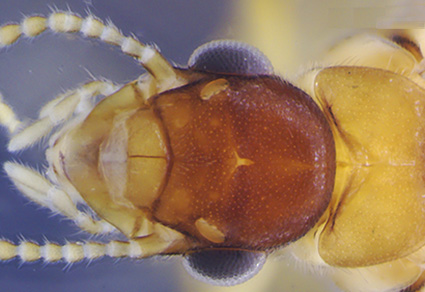Abstract
A new monotypic nasute termite genus, Hyleotermes gen. nov., is proposed for Nasutitermes brevipilus Emerson, 1925. Hyleotermes brevipilus, comb. nov., is redescribed and illustrated based on the morphology of the imago, soldier, and worker castes. It is expanded into Amazonia. The soldier of Hyleotermes differs from that of Nasutitermes Dudley, 1890 in that the former has a long and cylindrical nasus and the head capsule lacks long setae and is covered with microscopic setae. Unlike the worker of Nasutitermes, the Hyleotermes worker has a short mixed segment and an enteric valve is adorned with narrow spines on conical bases. The phylogenetic position of H. brevipilus comb nov., is reconstructed based on a dataset with two mitochondrial markers (COI and 16SrRNA) for 36 terminals, under maximum likelihood and Bayesian inference. Results corroborate that this species is unrelated to Nasutitermes and should be excluded from the genus.
References
Arab, D.A., Namyatova, A., Evans, T.A., Cameron, S.L., Yeates, D.K., Ho, S.Y. & Lo, N. (2017) Parallel evolution of mound-building and grass-feeding in Australian nasute termites. Biology Letters, 13, 20160665. https://doi.org/10.1098/rsbl.2016.0665
Bourguignon, T., Lo, N., Šobotník, J., Ho, S.Y.W., Iqbal, N., Coissac, E., Lee, M., Jendryka, M.M., Sillam-Dussès, D., Křížková, B., Roisin, Y. & Evans T.A. (2017) Mitochondrial phylogenomics resolves the global spread of higher termites, ecosystem engineers of the tropics. Molecular Biology and Evolution, 34, 589–597. https://doi.org/10.1093/molbev/msw253
Boulogne, I., Constantino, R., Amusant, N., Falkowski, M., Rodrigues, A.M.S. & Houël, E. (2017) Ecology of termites from the genus Nasutitermes (Termitidae: Nasutitermitinae) and potential for science-based development of sustainable pest management programs. Journal of Pest Science, 90, 19–37. https://doi.org/10.1007/s10340-016-0796-x
Constantino, R. (1991) Ereymatermes rotundiceps, new genus and species of termite from the Amazon Basin (Isoptera, Termitidae, Nasutitermitidae). Goeldiana Zoologia, 8, 1–11.
Constantino, R. (2002) Notes on the type-species and synonymy of the genus Nasutitermes (Isoptera: Termitidae: Nasutitermitinae). Sociobiology, 40, 533–537.
Dietrich, C. & Brune, A. (2016) The complete mitogenomes of six higher termite species reconstructed from metagenomic datasets (Cornitermes sp., Cubitermes ugandensis, Microcerotermes parvus, Nasutitermes corniger, Neocapritermes taracua, and Termes hospes). Mitochondrial DNA, Part A, 27, 3903–3904. https://doi.org/10.3109/19401736.2014.987257
Emerson, A.E. (1925) The termites from Kartabo, Bartica District, Guyana. Zoologica, 6, 291–459. https://doi.org/10.5962/p.190324
Fontes, L.R. (1986) Morphology of the worker digestive tube of the soil-feeding nasute termites (Isoptera, Termitidae, Nasutitermitinae) from the Neotropical region. Revista brasileira de Zoologia, 3, 475–501. https://doi.org/10.1590/S0101-81751986000400002
Hadley, A. (2010) CombineZP. Software. Available from: http://www.hadleyweb.pwp.blueyonder.co.uk (accessed 22 September 2022)
Hajibabaei, M., Janzen, D.H., Burns, J.M., Hallwachs, W. & Hebert, P.D. (2006) DNA barcodes distinguish species of tropical Lepidoptera. Proceedings of the National Academy of Sciences, 103, 968–971. https://doi.org/10.1073/pnas.0510466103
Hoang, D.T., Chernomor, O., Haeseler, A. von, Minh, B.Q. & Vinh, L.S. (2018) UFBoot2: Improving the Ultrafast Bootstrap Approximation. Molecular Biology and Evolution, 35, 518–522. https://doi.org/10.1093/molbev/msx281
Kambhampati, S. & Smith, P.T. (1995) PCR primers for the amplification of four insect mitochondrial gene fragments. Insect Molecular Biology, 4, 233–236. https://doi.org/10.1111/j.1365-2583.1995.tb00028.x
Katoh, K. & Standley, D.M. (2013) MAFFT multiple sequence alignment software version 7: improvements in performance and usability. Molecular Biology and Evolution, 30, 772–780. https://doi.org/10.1093/molbev/mst010
Katoh, K., Misawa, K., Kuma, K. & Miyata, T. (2002) MAFFT: a novel method for rapid multiple sequence alignment based on fast Fourier transform. Nucleic Acids Research, 30, 3059–3066. https://doi.org/10.1093/nar/gkf436
Krishna, K., Grimaldi, D.A., Krishna, V. & Engel, M.S. (2013) Treatise on the Isoptera of the world. Bulletin of the American Museum of Natural History, 377, 1–2704. https://doi.org/10.1206/377.1 https://doi.org/10.1206/377.2 https://doi.org/10.1206/377.3 https://doi.org/10.1206/377.4 https://doi.org/10.1206/377.5 https://doi.org/10.1206/377.6 https://doi.org/10.1206/377.7
Lanfear, R., Calcott, B., Ho, S.Y. & Guindon, S. (2012) PartitionFinder: combined selection of partitioning schemes and substitution models for phylogenetic analyses. Molecular Biology and Evolution, 29, 1695–1701. https://doi.org/10.1093/molbev/mss020
Lanfear, R., Frandsen, P.B., Wright, A.M., Senfeld, T. & Calcott, B. (2016) PartitionFinder 2: new methods for selecting partitioned models of evolution for molecular and morphological phylogenetic analyses. Molecular Biology and Evolution, 34, 772–773. https://doi.org/10.1093/molbev/msw260
Mathews, A.G.A. (1977) Studies on Termites from Mato Grosso State, Brazil. Academia Brasileira de Ciências, Rio de Janeiro, 267 pp.
Nguyen, L.-T., Schmidt, H.A., von Haeseler, A. & Minh, B.Q. (2015) IQ-TREE: A fast and effective stochastic algorithm for estimating maximum-likelihood phylogenies. Molecular Biology and Evolution, 32, 268–274. https://doi.org/10.1093/molbev/msu300
Noirot, C. (2001) The gut of termites (Isoptera). Comparative anatomy, systematics, phylogeny. I. Higher termites (Termitidae). Annales de la Société Entomologique de France, 37, 431–471.
Rambaut, A., Suchard, M.A, Xie, D. & Drummond, A.J. (2014) Tracer. Version 1.6. Available from: http://beast.bio.ed.ac.uk/Tracer (accessed 22 September 2022)
Ronquist, F. & Huelsenbeck, J.P. (2003) MrBayes 3: Bayesian phylogenetic inference under mixed models. Bioinformatics, 19, 1572–1574.
Roonwal, M.L. (1970) Measurement of termites (Isoptera) for taxonomic purposes. Journal of the Zoological Society of India, 21, 9–66.
Roy, V., Constantino, R., Chassany, V., Giusti‐Miller, S., Diouf, M., Mora, P. & Harry, M. (2014) Species delimitation and phylogeny in the genus Nasutitermes (Termitidae: Nasutitermitinae) in French Guiana. Molecular Ecology, 23, 902–920. https://doi.org/10.1111/mec.12641
Sands, W.A. (1965) A revision of the termite subfamily Nasutitermitinae (Isoptera, Termitidae) from the Ethiopian region. Bulletin of the British Museum (Natural History), Entomology, 4, 1–172.
Sands, W.A. (1998) The identification of worker castes of termite genera from soils of Africa and the Middle East. Cab International, Wallingford, 475 pp., 18 pls.
Simon, C., Frati, F., Beckenbach, A., Crespi, B., Liu, H. & Flook, P. (1994) Evolution, weighting and phylogenetic utility of mitochondrial gene sequences and a compilation of conserved polymerase chain reaction primers. Annals of the Entomological Society of America, 87, 651–701. https://doi.org/10.1093/aesa/87.6.651
Snyder, T.E. (1949) Catalog of the termites (Isoptera) of the World. Smithsonian Miscellaneous Collections, 112, 1–490.
deWaard, J.R., Ivanova, N.V., Hajibabaei, M. & Hebert, P.D.N. (2008) Assembling DNA Barcodes: Analytical Protocols. In: Cristofre, M.C. (Ed.), Methods in Molecular Biology 410: Environmental Genetics. Humana Press, Totowa, New Jersey, pp. 275–293. https://doi.org/10.1007/978-1-59745-548-0_15
Wessel, P. & Smith, W.H.F. (1998) New, improved version of Generic Mapping Tools released. EOS, Transactions of the American Geophysical Union, 79, 579. https://doi.org/10.1029/98EO00426


